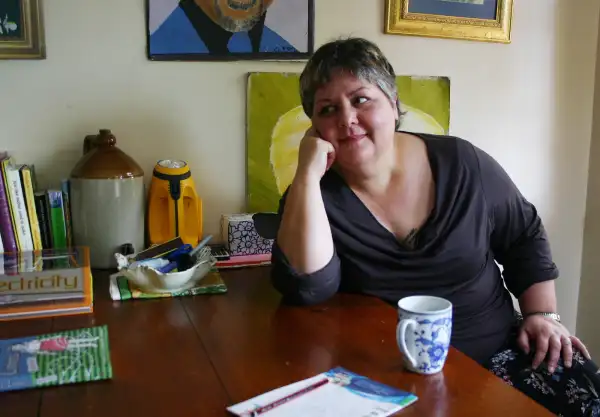Mastering the art of writing realistic conversations engages your reader in the story. Here’s why and how to do it.
BY ANDREW BAIRD
One of the great things about writing fiction is that you don’t have to tell the story all by yourself. You can delegate much of that responsibility to your characters. How? Through convincing dialogue.
In this article, we’ll look at why mastering the art of dialogue is essential to storytelling and how to write realistic and engaging conversations.
Let’s dive in.
Why is dialogue important?
Think of a story as a journey through a treacherous marsh, filled with the trials, tribulations and triumphs of your characters. As the reader embarks on this adventure alongside your characters, dialogue is like a path of well-placed stepping stones leading them deeper into the narrative.
Including dialogue in your story serves several crucial purposes:
- Revealing character. In real life, people reveal who they are through their actions, speech and interactions. Fictional characters are no different – dialogue is an effective way to establish their personalities, emotions, thoughts and behaviours.
For instance, consider this line from Jane Eyre by Charlotte Brontë, where the character Jane illustrates her free-spirited nature:
‘I am no bird; and no net ensnares me: I am a free human being with an independent will.’
- Exploring relationships. Dialogue offers a window into character relationships. The reader can learn a lot about the dynamics between characters from what they say to one another and how they say it.
For example, the opening scene of Jane Austen’s Pride and Prejudice demonstrates Mr Bennet’s indifferent tolerance of his wife’s love of gossip:
‘My dear Mr. Bennet,’ said his lady to him one day, ‘have you heard that Netherfield Park is let at last?’
Mr. Bennet replied that he had not.
‘But it is,’ returned she; ‘for Mrs. Long has just been here, and she told me all about it.’
Mr. Bennet made no answer.
‘Do you not want to know who has taken it?’ cried his wife impatiently.
‘You want to tell me, and I have no objection to hearing it.’
This was invitation enough.
- Advancing the plot. A story without dialogue is like a sailing boat on a windless day – stationary. Dialogue adds wind to the sail, powering the story towards its climax.
- Holding the reader’s attention. Long sections of descriptive writing can be tedious to read. Interspersing the text with conversation keeps the reader engaged by breaking the monotony and increasing the pace.
- Reflecting character growth. Changes in conversational styles often mirror character development. For example, an initially agitated character might begin to speak more calmly and openly as the unfolding story resolves the source of their distress.
- Establishing setting and context. In establishing where and when a story takes place, dialogue is just as effective as vivid description. The references characters make and their manner of speech can easily indicate their location and time period without the need for exposition.
Note how the following extracts illustrate different settings with their distinct language usage and sentence styles:
Excerpt from The Great Gatsby by F. Scott Fitzgerald, set in 1922, New York:
‘Why, I thought—why, look here, old sport, you don’t make much money, do you?’
Excerpt from NW by Zadie Smith, set in contemporary London:
A look of blank contempt passes over Shar’s face. Leah talks into it.
‘She’s got kids. Lives just over there, in the posh bit, on the park. She’s a lawyer now. Barrister. What’s the difference? Maybe there isn’t one. They’ve two kids. The kids love Olive, the dog’s called Olive.’
She is just saying sentences, one after the other, they don’t stop.
Learn more:
Your Guide to Writing Better Dialogue
Tips for writing realistic conversations
Now that we’ve established the why, check out these tips on how to go about writing realistic dialogue:
- Observe real conversations. Listen to real people and take note of their conversational patterns. Pay attention to how they speak, including interactions, repetitions, interruptions and the natural flow of conversation. Don’t forget to observe tone, pauses and expressions too. Incorporate these observations into your dialogue. Your readers will notice, and your writing will be more believable.
- Keep it short and focused. This tip applies to all writing, but it’s especially true for dialogue. Real conversations aren’t filled with Shakespearean monologues. Instead, there’s usually a quick back-and-forth of short sentences.
- Avoid info-dumping. Conversations need to have a purpose beyond dumping a truckload of information on the reader. It’s more effective to drip-feed information by letting the conversation unfold naturally. This regulates the story’s pace.
- Be sparing with ‘tech talk’. Unless you’re writing for Elon Musk, use plain language. Technical language doesn’t typically feature in normal conversation. Keep that fancy jargon locked away in a high-tech vault.
- Read the dialogue out loud. By reading aloud, you’ll be able to hear how the dialogue actually sounds. It helps you confirm the flow and rhythm of the conversation. Errors will become obvious, much like a bit of toilet paper stuck to someone else’s shoe.
Let’s apply a couple of these tips to an example. Note how stinted and unnatural the following dialogue is:
‘Hello Miriam!’
‘Hi Josephine. How are things going today?’
‘I’m well overall. Although, I’ve been assessing how compatible I am with Marcia and have analysed the pros and cons of our relationship. I took into account so many key characteristics and have determined a conclusion.’
Now, let’s try to improve it by applying the first two tips from the list above:
‘Hey Miriam, how’s life?’
‘Hellooo Josephine, I’m so good! How ‘bout you?’
‘Ahhh, to be honest I’m in a bit of a tough place with Marcia.’
‘Oh. Want to tell me more?’
‘Yeah, it’s a bit complicated. I’ve been thinking a lot about how I feel. And well, I just have no idea about ‘us’ anymore.’
See how much better that is? The second piece is more realistic, uses simple language, has shorter sentences and sounds like real people chatting.
Read more:
How to Write Effective Dialogue
How Do You Write Dialogue That Sounds Natural and Engaging?
How To Write Realistic Dialogue
To close, Stephen King puts it aptly: ‘Writing good dialogue is art as well as craft’.
Use these tips to craft conversations that are realistic and engaging to the reader.

About the Author
Andrew Baird is a freelance writer living in Wellington and is also a team leader at an engineering consultancy working on projects in the electricity sector. When Andrew isn’t writing or engineering, you’ll most likely find him exploring the outdoors, a new place, or connecting with his friends and family. Andrew is also an advocate for enjoying a balanced life that is kind to others and our one planet.













